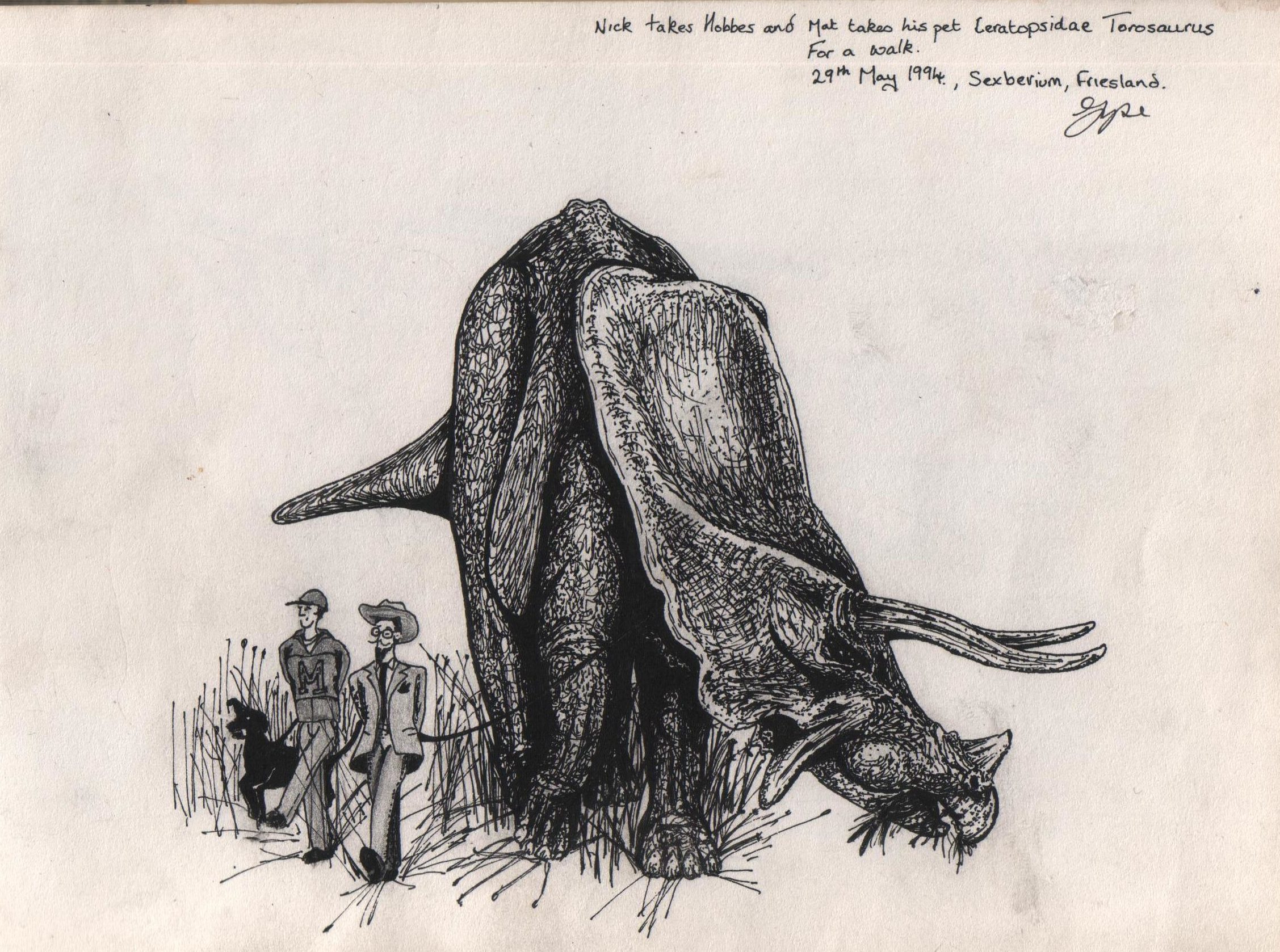Description
Walking With Triceratops
Walking With Triceratops: A favourite pencil, pen and ink drawing of Nick, walking his dog and Matthew, walking his Triceratops. 19cm x 14cm (image size). 31cm x 26cm (framed size).
The dinosaur belongs to a genus of herbivorous ceratopsid dinosaur that first appeared during the late Maastrichtian stage of the late Cretaceous period, about 68 million years ago (mya) in what is now North America. It is one of the last known non- avian dinosaur genera, and became extinct in the Cretaceous–Paleogene extinction.
The dinosaur’s name, which literally means “three-horned face”, is derived from the Greek τρί- (tri-) meaning “three”, κέρας (kéras) meaning “horn”, and ὤψ (ops) meaning “face”. It has been documented by numerous remains collected since the genus was first described in 1889, including at least one complete individual skeleton. Paleontologist John Scannella observed: “It is hard to walk out into the Hell Creek Formation and not stumble upon a Triceratops weathering out of a hillside.” Forty-seven complete or partial skulls were discovered in just that area from 2000 to 2010. Specimens representing life stages from hatchling to adult have been found. As the archetypal ceratopsid, Triceratops is one of the most popular dinosaurs, and has been featured in film, postal stamps, and many other types of media.
Torosaurus as growth stage of Triceratops
The drawing was created back in the 1990’s when Torosaurus was seen as a seperate species of Ceratopsids.
Torosaurus is a ceratopsid genus first identified from a pair of skulls in 1891, two years after the identification of Triceratops. The Torosaurus genus resembles Triceratops in geological age, distribution, anatomy and physical size and it has been recognised as a close relative. Its distinguishing features are an elongated skull and the presence of two fenestrae, or holes, in the frill. Paleontologists investigating dinosaur ontogeny (growth and development of individuals over the life span) in the Hell Creek Formation, Montana, US, have recently presented evidence that the two represent a single genus.
A, Triceratops prorsus holotype YPM 1822 and B, Torosaurus latus ANSP 15192
John Scannella, in a paper presented in Bristol, UK at the conference of the Society of Vertebrate Paleontology (25 September 2009) reclassified Torosaurus as especially mature Triceratops individuals, perhaps representing a single sex. Jack Horner, Scannella’s mentor at Bozeman Campus, Montana State University, noted that ceratopsian skulls consist of metaplastic bone. A characteristic of metaplastic bone is that it lengthens and shortens over time, extending and resorbing to form new shapes. Significant variety is seen even in those skulls already identified as Triceratops, Horner said, “where the horn orientation is backwards in juveniles and forward in adults”. Approximately 50% of all subadult skulls have two thin areas in the frill that correspond with the placement of “holes” in Torosaurus skulls, suggesting that holes developed to offset the weight that would otherwise have been added as maturing individuals grew longer frills. A paper describing these findings in detail was published in July 2010 by Scannella and Horner. It formally argues that Torosaurus and the similar contemporary Nedoceratops are synonymous with Triceratops.


Reviews
There are no reviews yet.